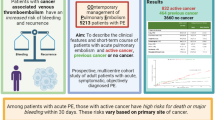Abstract
Cancer is one of the most common risk factors for acute pulmonary embolism (PE), but only few studies report on the short-term outcome of patients with PE and a history of cancer. The aim of the study was to assess whether a cancer diagnosis affects the clinical presentation and short-term outcome in patients hospitalized for PE who were included in the Italian Pulmonary Embolism Registry. All-cause and PE-related in-hospital deaths were also analyzed. Out of 1702 patients, 451 (26.5 %) of patients had a diagnosis of cancer: cancer was known at presentation in 365, or diagnosed during the hospital stay for PE in 86 (19 % of cancer patients). Patients with and without cancer were similar concerning clinical status at presentation. Patients with cancer less commonly received thrombolytic therapy, and more often had an inferior vena cava filter inserted. Major or intracranial bleeding was not different between groups. In-hospital all-cause death occurred in 8.4 and 5.9 % of patients with and without cancer, respectively. At multivariate analysis, cancer (OR 2.24, 95 % CI 1.27–3.98; P = 0.006) was an independent predictor of in-hospital death. Clinical instability, PE recurrence, age ≥75 years, recent bed rest ≥3 days, but not cancer, were independent predictors of in-hospital death due to PE. Cancer seems a weaker predictor of all-cause in-hospital death compared to other factors; the mere presence of cancer, without other risk factors, leads to a probability of early death of 2 %. In patients with acute PE, cancer increases the probability of in-hospital all-cause death, but does not seem to affect the clinical presentation or the risk of in-hospital PE-related death.

Similar content being viewed by others
References
Trujillo-Santos J, Casas JM, Casado I et al (2011) Thirty-day mortality rate in women with cancer and venous thromboembolism. Findings from the RIETE Registry. Thromb Res 127(Suppl 3):S1–S4
Prandoni P, Lensing AW, Piccioli A et al (2002) Recurrent venous thromboembolism and bleeding complications during anticoagulant treatment in patients with cancer and venous thrombosis. Blood 100(10):3484–3488
Heit JA, O’Fallon WM, Petterson TM et al (2002) Relative impact of risk factors for deep vein thrombosis and pulmonary embolism: a population-based study. Arch Intern Med 162(11):1245–1248
Connolly GC, Francis CW (2013) Cancer-associated thrombosis. Hematology Am Soc Hematol Educ Program 2013:684–691
Khorana AA, Dalal M, Lin J et al (2013) Incidence and predictors of venous thromboembolism (VTE) among ambulatory high-risk cancer patients undergoing chemotherapy in the United States. Cancer 119(3):648–655
Stein PD, Beemath A, Meyers FA et al (2006) Incidence of venous thromboembolism in patients hospitalized with cancer. Am J Med 119(1):60–68
Gussoni G, Frasson S, La Regina M et al (2013) Three-month mortality rate and clinical predictors in patients with venous thromboembolism and cancer. Findings from the RIETE registry. Thromb Res 131(1):24–30
Casazza F, Becattini C, Bongarzoni A et al (2012) Clinical features and short term outcomes of patients with acute pulmonary embolism. The Italian Pulmonary Embolism Registry (IPER). Thromb Res 130(6):847–852
Torbicki A, Perrier A, Konstantinides S et al (2008) Guidelines on the diagnosis and management of acute pulmonary embolism: the Task Force for the Diagnosis and Management of Acute Pulmonary Embolism of the European Society of Cardiology (ESC). Eur Heart J 29(18):2276–2315
Ribeiro A, Lindmarker P, Johnsson H et al (1999) Pulmonary embolism: one-year follow-up with echocardiography doppler and five-year survival analysis. Circulation 99(10):1325–1330
Yang D. Build prognostic nomograms for risk assessment using SAS. In: Proceedings of SAS Global Forum 2013. Paper 264–2013. http://support.sas.com/resources/papers/procee12.dings13/264–2013.pdf
Goldhaber SZ, Visani L, De Rosa M (1999) Acute pulmonary embolism: clinical outcomes in the International Cooperative Pulmonary Embolism Registry (ICOPER). Lancet 353(9162):1386–1389
Konstantinides S, Geibel A, Olschewski M et al (1997) Association between thrombolytic treatment and the prognosis of hemodynamically stable patients with major pulmonary embolism: results of a multicenter registry. Circulation 96(3):882–888
Agnelli G (1997) Venous thromboembolism and cancer: a two-way clinical association. Thromb Haemost 78(1):117–120
Agnelli G, Verso M, Mandalà M et al (2014) A prospective study on survival in cancer patients with and without venous thromboembolism. Intern Emerg Med 9(5):559–567
Ho G, Brunson A, White R et al (2015) Vena cava filter use in cancer patients with acute venous thromboembolism in California. Thromb Res 135(5):809–815
den Exter PL, Gómez V, Jiménez D, Trujillo-Santos J, Muriel A, Huisman MV (2013) Monreal M; Registro Informatizado de la Enfermedad TromboEmbólica (RIETE) Investigators. A clinical prognostic model for the identification of low-risk patients with acute symptomatic pulmonary embolism and active cancer. Chest 143(1):138–145
Kline JA, Roy PM, Than MP, Hernandez J, Courtney DM, Jones AE, Penaloza A, Pollack CV Jr (2012) Derivation and validation of a multivariate model to predict mortality from pulmonary embolism with cancer: the POMPE-C tool. Thromb Res 129(5):e194–e199
Kabrhel C, Sacco W, Liu S, Hariharan P (2010) Outcomes considered most important by emergency physicians when determining disposition of patients with pulmonary embolism. Int J Emerg Med. 3(4):239–264
Author information
Authors and Affiliations
Corresponding author
Ethics declarations
Funding
This study was performed without any external support.
Conflict of interest
The authors declare that they have no conflict of interest.
Statement of human and animal rights
All procedures were done in accordance with the Helsinki declaration 1964 and its later amendments.
Informed consent
After elucidations of the study purpose, a consent was obtained from patients.
Electronic supplementary material
Below is the link to the electronic supplementary material.
Rights and permissions
About this article
Cite this article
Casazza, F., Becattini, C., Rulli, E. et al. Clinical presentation and in-hospital death in acute pulmonary embolism: does cancer matter?. Intern Emerg Med 11, 817–824 (2016). https://doi.org/10.1007/s11739-016-1431-9
Received:
Accepted:
Published:
Issue Date:
DOI: https://doi.org/10.1007/s11739-016-1431-9




